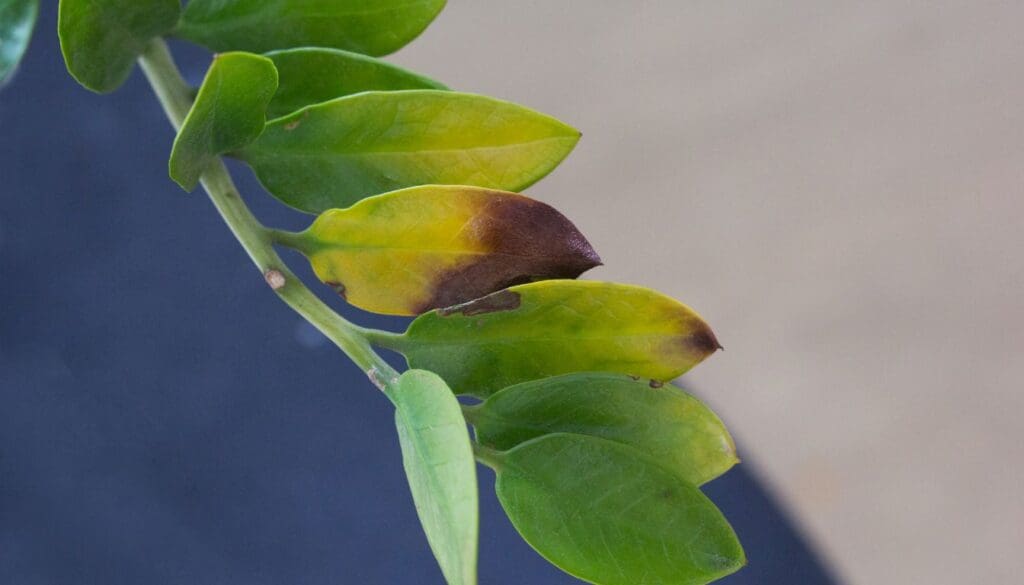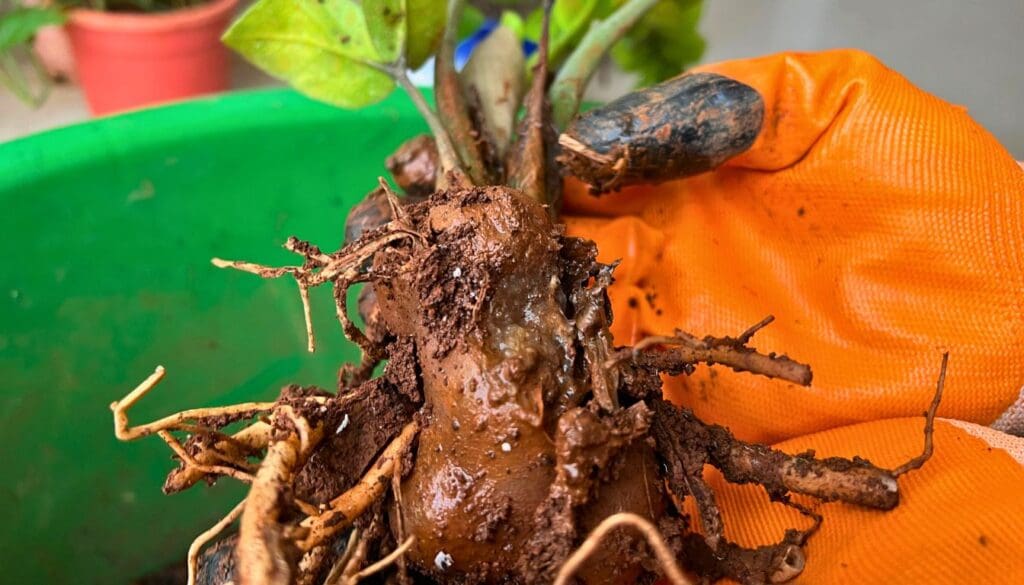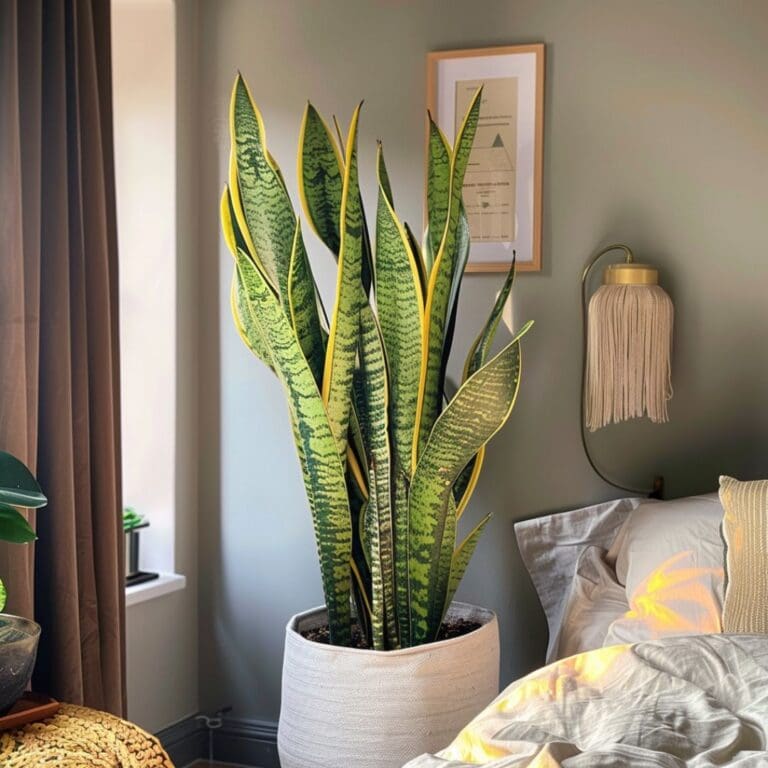9 Signs Why Your ZZ Plant Is Dying
ZZ plant (Zamioculcas zamiifolia) is popular among urban plant lovers who love to keep plants in their houses as it requires low maintenance. But not everyone can keep their ZZ plant thriving. Do you feel your ZZ plant is dying? What are the signs, and how to tackle these? Let’s find out!
Yellow leaves, shriveled stems, drooping leaves, brown tips, and scorched leaves are common signs of a dying ZZ plant. If you notice any unusual change in your plant, then it is a good idea to investigate. Small signs are often ignored, but these can lead to wilting of your ZZ plant.
Overwatering, too much heat, low humidity, poor drainage system, and many other problems as such can contribute to causing issues in your ZZ plant.
Finding what is wrong with your ZZ plant might seem to be a daunting task, but if you do your research well, it will be easier for you to understand. Also, you’ll get better at it with experience.
Let’s take a look at signs that your ZZ plant is dying and needs your help.
Please note: If you notice any sign that is different from usual, it is an indication that your plant needs help.
Please note: Simplify Plants is reader-supported. Some links in the post are affiliate links and I get a commission from purchases made through links in the post.
Leaves start to turn yellow

ZZ plants have green leaves. When you see a healthy ZZ plant, you’ll know it by the leaf’s color and texture. The color is mostly dark green for matured leaves, and the texture is glossy and thick.
However, you might see that some leaves are turning yellow. It can happen with the leaves of an individual stem or with all leaves of the plant.
The yellowing of leaves doesn’t mean that your plant is dying already, but it is an indication that something is wrong.
The reason for this can be that you are overwatering the plant. Overwatering is one of the common problems in ZZ plants. When the roots are wet for too long, the plant shows the signs through the leaves, and the leaves turn yellow.
So you need to make sure that you are not watering too much and the pot or the container has enough drainage holes to let the excess water drain away and not get stored in the soil for long.
Another reason that can be a cause of yellow leaves is that it is too hot. The weather might be too hot, or your house is getting too hot for the plant, which is why the leaves are turning yellow.
You can move your ZZ plant to an aerated area where there is moving air so that the plant can cool down and not suffer due to the heat.
Brown tips start appearing

Sometimes you might get brown tips or brown edges on your plant. These don’t turn into spots. And these indicate that the water you are using on the plant has too much chlorine or fluorine.
If this problem persists, the leaves get extremely dry, and when you touch the leaves, they fall off.
If you can realize and detect the problem early on then, you can save your ZZ plant from wilting. But if you don’t pay attention, your ZZ plant may end up dying.
You can just use some other water source like rainwater. Or you can keep your tap water, which you usually use; outside in an aerated area for 24-48 hours, and that might reduce the chlorine and fluorine.
If your plant has been potted in the same pot for a long time, some years maybe, it can cause brown tips and edges in leaves.
This is because the soil has not been changed for long, and it has a high amount of salt buildup that can harm the roots of the plant.
The old soil also fails to hold water, and it goes out through the drainage holes of the pot. So the plant does not get enough nutrition and water.
Another common problem is your ZZ plant is root-bound. So, make sure you keep an eye out for that.
The solution is to repot the plant to a new pot with fresh soil, which will give the water and nutrients back to it, and it will get back to health.
Another reason can be that the humidity is too high in and around your house.
Try to keep the plant in a place where it gets a lot of air. You can open the windows of the room so that air can flow in and reduce the humidity.
Scorched leaves and foliage

Sometimes your ZZ plant might have scorched leaves. There are various causes of scorched leaves in the ZZ plant. Some of the common ones are:
The plant is getting too much sunlight, due to which the leaves are getting scorched.
ZZ plants are not fond of direct sunlight, and this can be harmful to them. It would be best if you put them in an area where they get indirect light.
Overfertilization is also a common cause of scorched leaves. ZZ plants do not need a lot of fertilizer like many other plants. Giving too much fertilizer can damage the plant.
If you want to check that the plant has got excessive fertilizer, you can check the soil, and it will have white, fuzzy things which are nothing but excess salts.
You need to get rid of that soil and repot the plant in new soil. Fertilize once a month during the growing season(summers) only.
Please note that scorched leaves can be fixed by trimming away the damaged part, repotting the plant, and moving them to the right spot.
However, if your ZZ plant is left exposed to intense sun or overfertilized regularly, then they are likely to die.
Also read: How much light do ZZ plant need?
Leaves start drooping

You will notice that the leaves of the plant are drooping and getting thin. Usually, leaves of the ZZ plant have a thick texture like succulents, but they will get visibly thinner in this case.
The reason can be that you are not watering the plant enough. Or the humidity is extremely low in your area.
Due to the low humidity, the water evaporates from the plant. When it is not getting enough water, the plants start taking water from the leaves, stems, rhizomes and start looking tired.
To deal with this, you need to water the plant a little more than what you do or, if possible, try to raise the humidity inside the house.
Underwatering and low humidity can stress your ZZ plant in the long run, leading to weak foliage, and in some cases, it will leave you with a wilted plant.
New leaves are discolored
If your ZZ plant doesn’t get enough light, the new leaves don’t turn dark green. It is not a severe problem if you notice it on time.
The new leaves that appear are usually light green with a yellow hint to them. But as it matures, it should become the usual dark green color.
If that does not happen, it means it is not getting enough light. In such a case, you need to move the plant to an area where there is more light.
When the plant doesn’t get enough light, the photosynthesis gets slow, so the plant doesn’t behave normally and can’t grow properly.
So when you move the plant to an area with a lot of light, photosynthesis will speed up, and the leaves will start becoming dark green.
It is important to note that the ZZ plant can survive in low light, but the plant’s growth will be affected.
Sometimes when you move a ZZ plant from a bright light area to an extremely low light area, then the plant may start wilting due to shock.
It usually happens when we extremely change the environment around the plant. So, discolored leaves are early signs of a dying plant.
Black spots start appearing on the leaves
You might notice yellow hints on the tips, edges, or directly on the leaves that turn into black spots eventually. You will see black dots with a yellow outline on the leaves.
That happens due to fungus or bacteria. The bacteria travel to the leaves from the roots, and the leaves show the sign through these spots.
To get rid of this problem, you need to cut off all the infected leaves, and if any stem has a lot of infected leaves, you can clip off the stem.
It would be best if you considered repotting the plant as the new soil will not have bacteria and fungus, and the ZZ plant will be able to get rid of the infections faster.
Black spots can quickly take over your ZZ plant, and if you don’t act quick enough, your plant may end up dying.
Mushy stems with black spots

Sometimes you can notice that the stem of the ZZ plant has black spots on it. Though it might seem like a problem, most probably it is not.
It is completely natural for ZZ plants to have these spots on the stem. You just need to check that the spots are not mushy.
However, if the spots start feeling mushy when you touch them, and start to bulge out, then it might be due to fungus or bacteria, and you would need to cut that stem and repot the plant to get rid of all the infections.
Mushy stems can kill the ZZ plant if you don’t act quick enough.
Stems start shriveling

Shriveling of stems is a common problem in ZZ plants. And this happens when the plant doesn’t get enough water.
In these cases, you will notice that the thick parts of the stem near the soil will start to shrivel and start getting cavities all around the stem. It will start getting drained of water and will become dry.
It can also happen if the plant is placed in a hot area with direct sunlight and the water evaporates from the leaves.
The nutrients also evaporate along with water, and that is when the plants suck up the water and nutrients from the storage unit, which is the thick stem area and rhizomes. So when that happens, the stems start to shrivel.
You need to keep your ZZ plant in an area that is not too hot, does not have direct sunlight, and water the plant properly.
Please note that shriveling of leaves is a major problem in the ZZ plant. Your plant is likely to die soon if you don’t get to the root of the problem and fix it.
Root rot have damaged the foliage and roots

Root rot is a severe issue as it is hard to notice in the initial stages, but it might get very late when you understand that this might be the problem, and the plant can die.
The most common cause of root rot in ZZ plants is overwatering, poor drainage of water, unsuitable soil, lack of drainage holes in pot or container, pathogenic infections, etc.
Some signs of root rot are drooping stems, smelly soil, mushy roots, etc.
If you doubt that your plant has root rot, you need to take the plant out of the container by flipping it gently, and then you can rinse the roots and look for mushy brown roots. These are the roots suffering from root rot.
There are many steps to get rid of this. In short, you can cut the roots that are grey or brown and mushy, and you can report the plant in a clean pot or container that has enough drainage holes for water to pass. You also need to use soil that can provide a sound drainage system.
To avoid all the problems that have been mentioned above, you need to maintain a schedule and care for your plant.
ZZ plants don’t need a lot of care and are very easy to handle. But you need to keep an eye out for any problem that might arise, and you can deal with it at the primary stage and get rid of it.
Root rot is a critical condition, and it can be impossible to bring your plant back to health if it is not treated early. Thus, make sure you keep an eye out for the same.
Also read: How Do I Save My ZZ Plant From Root Rot?
Tips to keep your ZZ plant healthy

Here are some tips to keep in mind for you if you want to keep your ZZ plant healthy and thriving:
- Maintain a watering schedule for your ZZ plant so that it is neither overwatered nor under-watered, as both of these conditions can cause problems.
- Use soil that supports well drainage of water. Don’t use soil that is clayey as that would retain water.
- Don’t keep your ZZ plant under direct sunlight, as ZZ plants don’t like that. Instead, keep them in a bright area that has indirect light.
- Make sure not to use water that has chlorine or fluorine in it.
- The area where you keep your ZZ plant should be well ventilated so that the plant can breathe. It will not cause any problem that might otherwise happen due to humidity.
- Use fertilizers once a month during the growing season.
- You might consider repotting the plant every few years so that the soil does not lack nutrition, and if it does, it can be changed with new and better potting soil. ZZ plants love to remain potted, and they love standing in the same place, but that might cause problems if not noticed.
- Do not deprive the plant of any kind of light. It needs light to be able to photosynthesize.
- Lack of light will make their growth slower than usual.
- If you find any infected area, like leaves, stems, or roots, consider cutting those areas with a clean and sharp scissor or knife so that the whole plant does not get infected.
- If the ZZ plant has severe root rot or bacteria and fungus infection, try to repot it as the old soil is likely to be contaminated and can re-infect the plant if not repotted.
Also read: How to save a dying ZZ plant?
Sources: ZZ plant study, College of agricultural studies, University of Vermont, National science foundation.
Recommended Garden Supplies
| Product Image | Our Recommended Gardening Supplies | Check Offers! |
|---|---|---|
Top Top
Top
Top
Top
Top
Top
Top
Top | rePotme Houseplant and Tropical Classic Potting Soil Mix | Check Offer On Amazon |
 Top
Top
Top
Top
Top
Top
Top
Top | Espoma Organic Indoor Plant Food | Check Offer On Amazon |
 Top
Top
Top
Top
Top
Top
Top
Top | GooingTop LED Grow Light 6000K Full Spectrum Clip Plant Growing Lamp | Check Offer On Amazon |
 Top
Top
Top
Top
Top
Top
Top
Top | Soil Moisture Meter | Check Offer On Amazon |
 Top
Top
Top
Top
Top
Top
Top
Top | Govee Hygrometer Thermometer, Bluetooth Enabled! | Check Offer On Amazon |
 Top
Top | LEVOIT Humidifiers for Large Room(Best For Plants) | Check Offer On Amazon |
 Top
Top
Top
Top
Top
Top
Top
Top | Upgraded DIY Automatic Drip Irrigation Kit, 15 Potted Houseplants Support | Check Offer On Amazon |
 Top
Top
Top
Top
Top
Top
Top
Top | Stainless Steel Heavy Duty Gardening Tool Set | Check Offer On Amazon |
 Top
Top
Top
Top
Top
Top
Top
Top | Bonide Insecticidal Soap | Check Offer On Amazon |
 Top
Top
Top
Top
Top
Top
Top
Top | Bonide 32 oz Spray Neem Oil for Organic Gardening | Check Offer On Amazon |
 Top
Top
Top
Top
Top
Top
Top
Top | Garden Safe Fungicide | Check Offer On Amazon |






